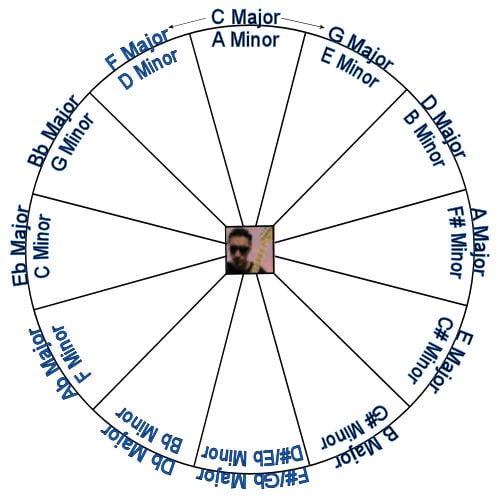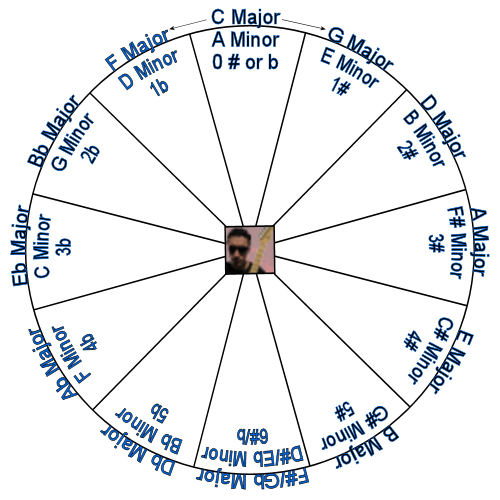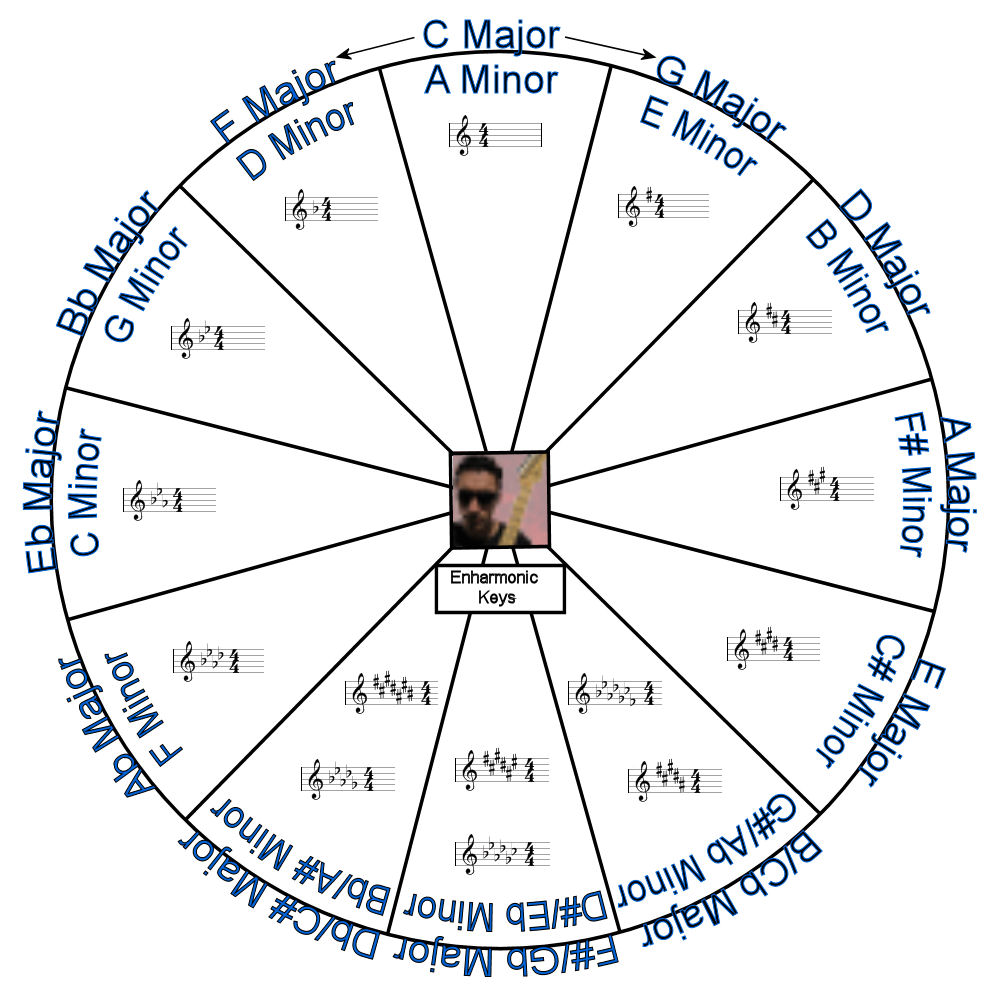Circle Of Fifths |
|
|
|
|
|
| Jun 15 2007, 03:28 AM |
|
Circle of Fifths Introduction The circle of fifths ... a lot of people ask what it is and how to use it, as if they hope it will solve all of the worlds problems. Whilst it won't do that, it is a very useful tool, and can help us in a number of ways. This lesson will describe what it is, and how we can get a lot of mileage out of this musical geometrical figure. The Circle So what is it? The circle of fifths is an arrangement of musical keys in a circular format that allows you to easily understand the relationship between those keys, and work out the number of sharps and flats there are in each key. If you need to learn a little more about keys I suggest you look at my music notation lesson here. Each Segment of the circle has a key associated with it, and we can make inferences about the properties of keys next to each other. Lets have a look at a special GMC version of the circle:  As you can see, it is fairly simple, a list of all 12 keys, laid out in a specific order (of which more later). Note that each Major key also has its relative minor key listed underneath. In terms of notes, the Major and its Relative minor are identical, so they share the same slot on the circle of fifths. If you want to learn more about relative minors, check out my lesson on the subject here. Another thing to note is that this really is a circle - once you have been around the circle once, the pattern repeats itself, so there is really no beginning or end, as you would expect from a circle. The 5ths So the circle part of the name is fairly obvious, what about the 5ths part? If you move around the circle clock wise, each key is separated from the preceding key by a 5th interval. C to G is a 5th, G to D is a 5th, and so on. If you go around the circle anti-clockwise, the keys are related by a 4th interval. Why is this? Well a backwards 5th is a 4th - lets see why. Imagine we are starting on the note of C. As we have seen above, a 5th interval is a G (C D E F G). But if we play that backwards, how do the notes G and C relate to each other? (G A B C) - a 4th. It might seem a little crazy that you go around one way and its 5ths, yet the other way is 4ths. the important point here is that we aren't traversing notes in a scale backwards and forwards, we are actually looking at the relationship between 2 notes as an interval, and we usually figure intervals moving upwards from the first note to the second. So to work out the interval between G and C, we don't count backwards (G F E D C), we count forwards (G A B C) and we get a 4th interval. So, move clockwise and we are switching between keys separated by a 5th interval, and anticlockwise we are switching between keys separated by a 4th interval. For this reason the circle of fifths is also known as the Circle of 4ths. Another way to look at it that might make a little more sense is that clockwise you are going up a 5th, anticlockwise you are going down a 5th. Its just that going down a 5th is exactly the same as going up a 4th in interval terms as I described above. Related Keys This is all very well but what does it give us? One of the important things the circle of fifths gives us is an easy way of finding keys that are musically related to each other. Keys next to each other differ by only one sharp or flat meaning that they actually share 7 of their 8 notes - this means that they are very similar sounding, and moving from one key to a key adjacent to it on the Circle is a musically pleasing and easily understood change, cnsisting of the sharpening or flattening of just a single note. For for instance, if you are in the key of G, the Circle immediately tells you that G and C are closely related keys and would be good candidates for a key change. (It can also tell us that a key and its relative minor are closely related since they share all the same notes). The reason for this closeness between keys separated by a 4th or 5th interval is easy to understand if you look at the formula for the major scale - remember that the gaps are specified by the formula 2-2-1-2-2-2-1 If we pick a couple of representative keys, C and G major, we can lay them out underneath each other and examine the differences. The scale of C starts with C as the tonic, G starts with G as the tonic (of course). As you can see from the diagram below, the formulae are offset by 5 steps (because of the 5th interval) and that means that they don't match exactly. They are pretty close however, and as you can see, the only difference is that a 2 and a 1 are flipped in the G major scale, which has the effect of sharpening the F to an F#, bu that is all since the next step (the G note) is pulled back in line with the C major scale because of the 1 semitone step after the F#:  This shows us why there is a close match between keys separated by a 5th, which explains why they sound good together. If you tried this same exercise with keys separated by a 2nd or 3rd, you would get many more differing notes, making those keys more distantly related. The same is true for keys separated by a 4th. Lets do the maths:  Its a similar story. In this case, again we have one different note, the Bb, all other notes are identical. Key Signatures What we just learned above leads us into interesting territory - that of key signatures. Its worth reading my lesson on musical notation here to understand a bit more about them. What the circle does is allow us to understand the different flats and sharps that belong with each key. As we saw above, moving clockwise from one key to the next introduces one additional sharp into the new scale. Moving anticlockwise has the effect of removing one sharp (or as we move through the key of C which has no sharps or flats, we start adding flats - this comes to the same thing, we are moving a note up or down a semitone in each case, its just that the notation changes when we move through C). This allows us to deduce the order of the keys and the number of sharps or flats they have as we move around the circle as follows:  Down at the bottom of the circle, something very interesting happens. You'll see that I marked that slot as "F# Major or Gb Major". How can it be both? It can be both because those 2 keys are enharmonic which is a term that means that they share the same distribution of sharps and flats. But don't just take my word for it, lets check that out. Our first clue is that Gb and F# are actually the same note, and we would expect that applying the major formula twice to the same note would get us the same scale! Lets work it through. We are still working with the major scale, so our formula is still 2-2-1-2-2-2-1. Lets start with Gb, and figure out the notes:  Now, lets do the same with F#:  Now we can compare the notes. They are pretty similar when you work through the sharps and flats: F# = Gb G# = Ab A# = Bb B = Cb C# = Db D# = Eb Gb = F# Well that all looks ok, apart from E# and F - what is this mysterious E#? In earlier lessons I told you that there was no such note as E#. That's a little white lie that makes things easier to start with. In actual fact, there really isn't a note of E#, but for notational reasons it can be useful to use the term. If you sharpen an E you get an F, so in fact E# is really the same as F, the subtle difference is that although they are the same note, they are working differently in the context of key signatures. F on its own is an unadulterated note that hasn't been sharpened or flattened. E# is used as notation to show that although we will be playing an F, we understand that it is an E that has been sharpened by the key signature. Ok, now that we know that E# is really an F, we can now see that the 2 scales are identical, or enharmonic. So flats and sharps meet in the middle in our wonderful circle of fifths. Now, if you wanted to you could push the flats further around the circle anti clockwise, and the sharps clockwise, and and up with even more sharps and flats. Although you do occasionally see pieces with 7 flats or 7 sharps, it is very unusual and a little pointless. As you move further round things start to get really out of whack, and you start to need double sharps and double flats to make things work out (a little like the concept of our E#). Deriving the Circle of Fifths and Associated Scales Just in case you are ever stranded without access to the increasingly useful circle of 5ths, here is a way you can build it up from first principles with just a little bit of knowledge, and a couple of simple rules. Let start at C - we know that C has no sharps or flats and is the start of the circle. First we want to build the circle up clockwise, and we know that the keys are 5th apart. Lets write down a scale of C: C D E F G A B C The 5th of the scale is G, so we now know that G is the next key around the circle. We also know from our earlier key comparisons that the difference between the 2 scales is a single sharp - the 7th note of our new scale (go check if you don't believe me - this falls out from the formula for the scale as we saw before). Knowing these two key facts we can now write out the scale for the next key in the circle, which is G major, by starting with our C major scale above, taking notes starting from the 5th of the scale, and sharpening the 7th note that we get to: G A B C D E F# G We can do this again to get the next key and scale - this time we start with our new scale of G, count 5 notes to get to the 5th and write notes from there sharpening the 7th D E F# G A B C# D Do this another 3 times and you have the clockwise half of the circle. Now we need to figure out the anticlockwise half of the circle. Again, we start with the scale of C: C D E F G A B C Since we are going anti clockwise, our new scale starts on the 4th of the scale - which is F. An from our key comparison above we saw that moving anti clockwise results in a flattening of the 4th of the new scale, so we can write down our new scale like this: F G A Bb C D E F And once again, we apply the same rule to get the next key and scale - the 4th is Bb, writing notes and flattening the new 4th when we get to it gives us: Bb C D Eb F G A B And so on - eventually we will get to the 6th slot and our circle will be complete! This exercise has also revealed something else of use to us - the order of the sharps and flats. If you were paying attention when you built the circle, and wrote down each new sharp as you came upon it you should have got F C G D A E B - this is useful to know, and most theory lessons would have you remember that sequence with a some sort of mnemonic - but we just figured it out from scratch using the circle of fifths, based on our understanding of how scales alter when they differ between 5 intervals - this is the very rule that early musical theorists used when building key signatures for the first time. The same is true for the flats - B E A D G C F. Finding the Order of Sharps and Flats Now, another trick - we know that to figure out the new sharp for each key around the circle, we just sharpen the 7th note of the new scale - just as we did above. The circle can help here. If you look at a particular key, say G and want to figure out the 7th note, just go back 2 steps on the circle - this gets us to F, which is the note we would sharpen when writing down the key of G, the first sharp in our list. We can extend this to each of the sharps, and you will notice that if you start 2 segments anticlockwise from the G, the key is F. Reading clockwise from F gives us F C G D A E B - the order of our sharps! This works because two 4th intervals added together in this way actually gives us a seventh. This is because when figuring intervals we always count the note we started from and the note we ended on. So, if we start at G and move through two complete 4ths it woks like this: G A B C C D E F Notice that we had to use C twice, and that in total we went from C to F, which is a seventh, not an octave as you might think. The practical upshot of this is that the order of the sharps can be read off from around the circle, starting 2 steps anticlockwise from the first key that has any sharps (G). To get the flats, the easiest way is to just reverse the order of the sharps, but you can also get that from the circle with a little effort. Chord Progressions One final trick from the ever useful circle - it will also quickly show you the subdominant(IV) and dominant(V) chords for a particular key, often used to build progressions. Once again, pick a key (F say) . Look Clockwise for your dominant or V chord © and anti clockwise for your subdominant or IV chord (Bb). These are the 3 most important chords in any key, and the Cricle helps us to easily locate them. The Finished Circle Ok, now we have talked about all the things the circle can do for us, lets put it all together in one big diagram - the GMC Cricle of Fifths!  Final Word So there you have it - the Circle of Fifths. Use it to: * Build a I,IV,V chord progression * Pick a key to modulate to * Spot a relative minor * Work out the number of sharps or flats in a key * Work out the individual sharps and fats in a key Not bad for a humble little circle! As usual, comments and questions in the forum! Parts of this lesson were based on material provided by Tsuki - thanks! -------------------- Check out my Instructor profile
Live long and prosper ... My Stuff: Electric Guitars : Ibanez Jem7v, Line6 Variax 700, Fender Plus Strat with 57/62 Pickups, Line6 Variax 705 Bass Acoustic Guitars : Taylor 816ce, Martin D-15, Line6 Variax Acoustic 300 Nylon Effects : Line6 Helix, Keeley Modded Boss DS1, Keeley Modded Boss BD2, Keeley 4 knob compressor, Keeley OxBlood Amps : Epiphone Valve Jnr & Head, Cockburn A.C.1, Cockburn A.C.2, Blackstar Club 50 Head & 4x12 Cab |
|
|
||
|
|
|
|
| Jun 15 2007, 03:32 AM |
|
I haven't read it yet - BUT THANK YOU ANDREW!
--------------------  Gear: Fender American Deluxe Stratocaster, Gibson '67 RI Flying V, Mesa Boogie F-30 112 combo, crazy pedals. Gear: Fender American Deluxe Stratocaster, Gibson '67 RI Flying V, Mesa Boogie F-30 112 combo, crazy pedals. |
|
|
||
|
|
|
|
| Jun 15 2007, 03:52 AM |
|
I haven't read it yet - BUT THANK YOU ANDREW! You thought I was just joking right ? -------------------- Check out my Instructor profile
Live long and prosper ... My Stuff: Electric Guitars : Ibanez Jem7v, Line6 Variax 700, Fender Plus Strat with 57/62 Pickups, Line6 Variax 705 Bass Acoustic Guitars : Taylor 816ce, Martin D-15, Line6 Variax Acoustic 300 Nylon Effects : Line6 Helix, Keeley Modded Boss DS1, Keeley Modded Boss BD2, Keeley 4 knob compressor, Keeley OxBlood Amps : Epiphone Valve Jnr & Head, Cockburn A.C.1, Cockburn A.C.2, Blackstar Club 50 Head & 4x12 Cab |
|
|
||
|
|
|
|
| Jun 15 2007, 04:01 AM |
|
Well, I knew you were up to something or other, so I figured it would be this I'm still digesting this, but I'll probably have a couple of questions for you later. I'm thinking maybe the complex chords lesson - I've been putting that one off for a while cos its going to be a big one ... This post has been edited by Andrew Cockburn: Jun 15 2007, 04:02 AM -------------------- Check out my Instructor profile
Live long and prosper ... My Stuff: Electric Guitars : Ibanez Jem7v, Line6 Variax 700, Fender Plus Strat with 57/62 Pickups, Line6 Variax 705 Bass Acoustic Guitars : Taylor 816ce, Martin D-15, Line6 Variax Acoustic 300 Nylon Effects : Line6 Helix, Keeley Modded Boss DS1, Keeley Modded Boss BD2, Keeley 4 knob compressor, Keeley OxBlood Amps : Epiphone Valve Jnr & Head, Cockburn A.C.1, Cockburn A.C.2, Blackstar Club 50 Head & 4x12 Cab |
|
|
||
|
|
|
|
| Jun 15 2007, 04:40 AM |
|
good stuff andrew. appreciated.
|
|
|
||
|
|
|
|
| Jun 20 2007, 11:47 PM |
|
That's a hell of a ugly guy in the middle of the circle!
No seriously - you are doing a fantastic job Andrew! Kris |
|
|
||
|
|
|
|
| Jun 21 2007, 09:17 PM |
|
I'm gonna have to read it again. Especially to Work out the number of sharps or flats in a key and Work out the individual sharps and flats in a key. Pretty interesting. It makes it sound so easy. How do you get to that big note in the hub of the circle. Is that a K note? Its all enharmonic my brother! g Its K# - cos Kris is a sharp kinda guy This post has been edited by Andrew Cockburn: Jun 22 2007, 03:14 PM -------------------- Check out my Instructor profile
Live long and prosper ... My Stuff: Electric Guitars : Ibanez Jem7v, Line6 Variax 700, Fender Plus Strat with 57/62 Pickups, Line6 Variax 705 Bass Acoustic Guitars : Taylor 816ce, Martin D-15, Line6 Variax Acoustic 300 Nylon Effects : Line6 Helix, Keeley Modded Boss DS1, Keeley Modded Boss BD2, Keeley 4 knob compressor, Keeley OxBlood Amps : Epiphone Valve Jnr & Head, Cockburn A.C.1, Cockburn A.C.2, Blackstar Club 50 Head & 4x12 Cab |
|
|
||
|
|
|
|
| Jun 22 2007, 03:05 PM |
|
As ever Kaneda, thanks for your insightful additions
Regards, Andrew -------------------- Check out my Instructor profile
Live long and prosper ... My Stuff: Electric Guitars : Ibanez Jem7v, Line6 Variax 700, Fender Plus Strat with 57/62 Pickups, Line6 Variax 705 Bass Acoustic Guitars : Taylor 816ce, Martin D-15, Line6 Variax Acoustic 300 Nylon Effects : Line6 Helix, Keeley Modded Boss DS1, Keeley Modded Boss BD2, Keeley 4 knob compressor, Keeley OxBlood Amps : Epiphone Valve Jnr & Head, Cockburn A.C.1, Cockburn A.C.2, Blackstar Club 50 Head & 4x12 Cab |
|
|
||
|
|
|
|
|
Jul 14 2007, 03:36 AM
|
|
I hope you realize that this is an important section. I'm sure a lot of us are reviewing the theory section.
|
|
|
||
|
|
|
|
| Jul 22 2007, 12:52 PM |
|
would that clash stick out like a sore thumb or would it be barely noticeable
-------------------- Ibanez sa260 (hell ya)
Ibanez 10 watt amp (hell no) |
|
|
||
|
|
|
|
| Jul 22 2007, 01:44 PM |
|
would that clash stick out like a sore thumb or would it be barely noticeable Try it and see! In general, quick passing notes that clash arent noticeable and contribute color to a melody, but if you for instance start or end a phrase on a clashing note and leave it out there in plain view for a while the yes it probably will clash. However, this may be an effect that you are looking for, so if it sounds cool to you its ok! -------------------- Check out my Instructor profile
Live long and prosper ... My Stuff: Electric Guitars : Ibanez Jem7v, Line6 Variax 700, Fender Plus Strat with 57/62 Pickups, Line6 Variax 705 Bass Acoustic Guitars : Taylor 816ce, Martin D-15, Line6 Variax Acoustic 300 Nylon Effects : Line6 Helix, Keeley Modded Boss DS1, Keeley Modded Boss BD2, Keeley 4 knob compressor, Keeley OxBlood Amps : Epiphone Valve Jnr & Head, Cockburn A.C.1, Cockburn A.C.2, Blackstar Club 50 Head & 4x12 Cab |
|
|
||
|
|
|
|
| Jul 22 2007, 02:06 PM |
|
when you play something you should be able to play it in all the scale .
so if you are practicing som wierd chord try do it in the order of circle and then you will end up doing it in all the keys. i use tons of times i seriously recommend it. Eyal -------------------- My gear:
Ibanez Rg2570, Pod XTL, peavey classic 30w Guitar it is a passion a link to the Aspiring instructor |
|
|
||
|
|
|
|
| Jul 23 2007, 08:57 PM |
|
thanx alot andrew and kaneda
-------------------- Ibanez sa260 (hell ya)
Ibanez 10 watt amp (hell no) |
|
|
||
1 User(s) are reading this topic (1 Guests and 0 Anonymous Users)
0 Members:






























